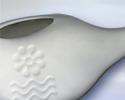Saline nasal washes
Salt water washes; Nasal irrigation; Nasal lavage; Sinusitis - nasal washA saline nasal wash helps flush pollen, dust, and other debris from your nasal passages. It also helps remove excess mucus (snot) and adds moisture. Your nasal passages are open spaces behind your nose. Air passes through your nasal passages before entering your lungs.
Nasal washes can help relieve nasal allergy symptoms and help prevent sinus infections (sinusitis).
- How to use Saline Nasal Washes
You can buy a device such as a neti pot, squeeze bottle, or rubber nasal bulb at your drug store. You can also buy saline solution made specifically for nasal rinses. Or, you can make your own rinse by mixing:
- 1 teaspoons (tsp) or 5 grams (g) canning or pickling salt (no iodine)
- A pinch of baking soda
- 2 cups (0.5 liters) warm distilled, filtered, or boiled water
To use the wash:
- Fill the device with half the saline solution.
- Keeping your head over a sink or in the shower, tilt your head sideways to the left. Breathe through your open mouth.
- Gently pour or squeeze the solution into your right nostril. The water should come out the left nostril.
- You can adjust the tilt of your head to keep the solution from going into your throat or into your ears.
- Repeat on the other side.
- Gently blow your nose to remove remaining water and mucus.
- Important Tips
You should:
- Be sure you only use distilled, boiled, or filtered water. While rare, some tap water may contain small germs that can cause infection.
- Always clean the neti pot or nasal bulb with distilled, boiled, or filtered water after every use and let it dry.
- Use the nasal wash before using other medicines, such as a nasal spray. This will help your nasal passages better absorb the medicine.
- It may take a few attempts to learn the technique of washing your nasal passages. You also may feel a slight burn at first, which should go away. If needed, use a little less salt in your saline solution.
- Do not use if your nasal passages are completely blocked.
- When to Call the Doctor
Be sure to contact your health care provider if you notice:
- Nosebleeds
- Fever
- Pain
- Headaches
References
DeMuri GP, Wald ER. Sinusitis. In: Bennett JE, Dolin R, Blaser MJ, eds. Mandell, Douglas, and Bennett's Principles and Practice of Infectious Diseases. 9th ed. Philadelphia, PA: Elsevier; 2020:chap 62.
Ivker RS. Chronic sinusitis. In: Rakel D, Minichiello VJ, eds. Integrative Medicine. 5th ed. Philadelphia, PA: Elsevier; 2023:chap 18.





